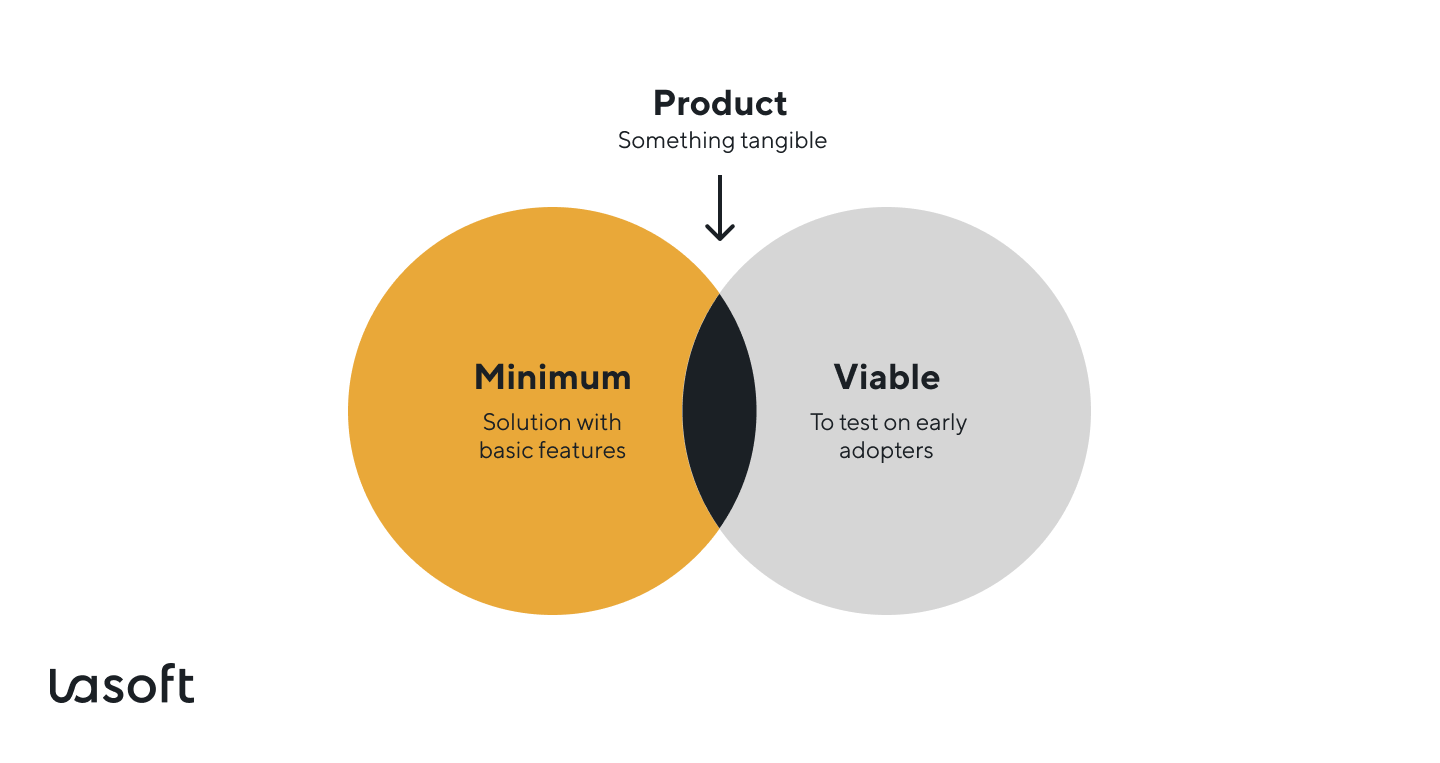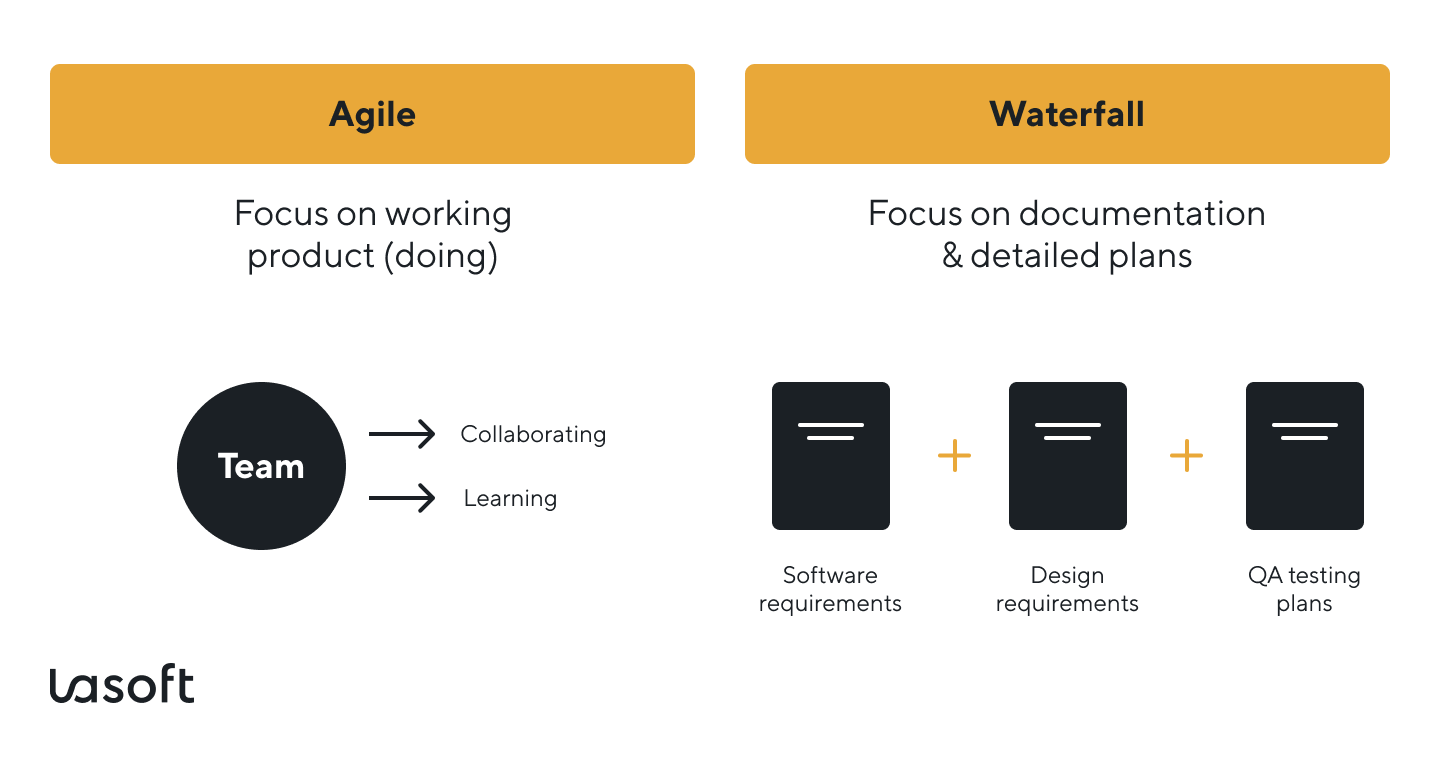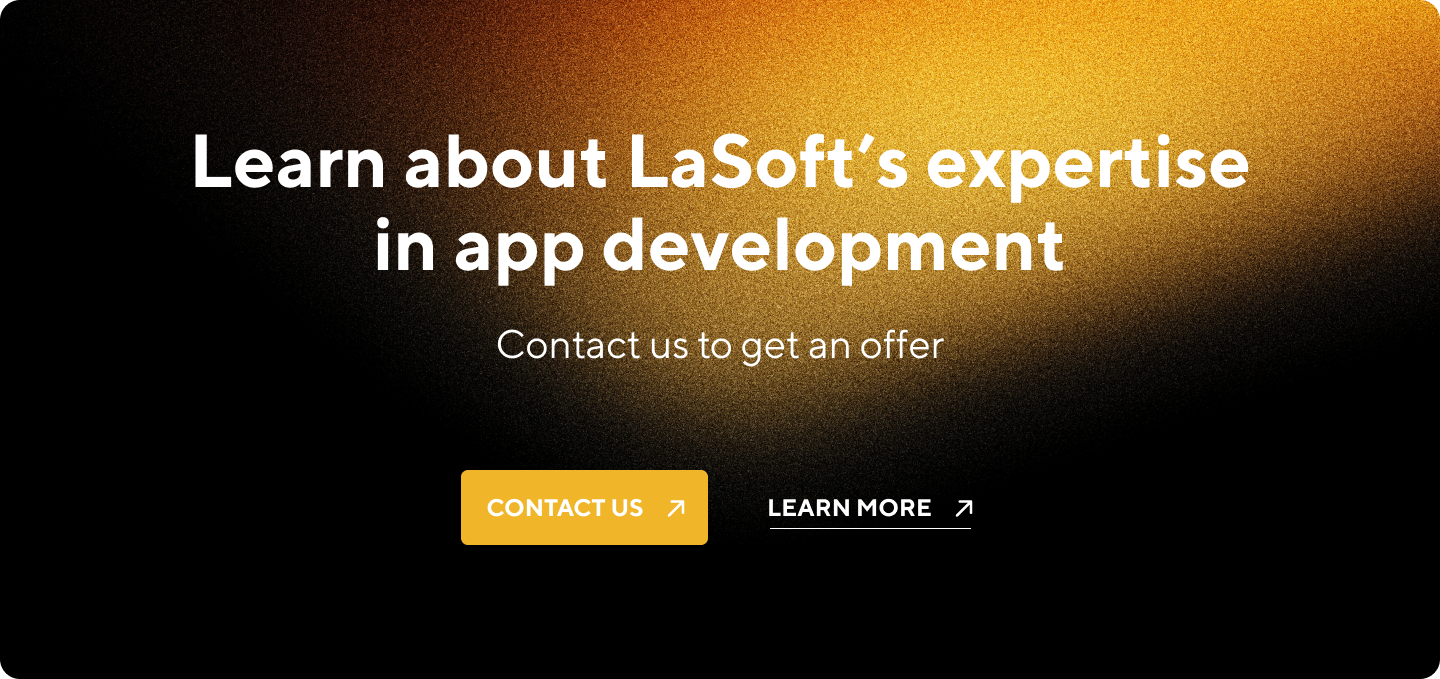After you have your business idea, you want to get to product development as soon as possible; that’s very important for the software development team.
That’s why MVP is part of your idea validation process and a cost-effective way to test users’ reactions to your product. Let’s explore how an MVP works in agile development when the team adopts an agile methodology. Whether you are an experienced business owner or a startup, understanding how to avoid common MVP mistakes effectively, you can grasp why building an MVP first is crucial for creating a commercially successful final product.

Understanding MVP Agile Development
The concept of a Minimum Viable Product has transformed the way we develop software and digital products, particularly in agile development. It’s a version of your product with just enough features to interact with users and interest early adopters. It helps you test your product idea by researching clients’ opinions, adding valuable features, and elevating UX or UI, depending on the research outcome.
In the past, development cycles were long, and feedback came late. With Agile MVP, the focus is on acting fast and learning quickly. User story mapping and a product with core features helps get to real target audience sooner. This enables you to collect meaningful feedback. You can then use this feedback for iterative development, which ensures that your product meets market needs better over time.
It’s also vital to understand the difference between MVP (minimum viable product) and prototypes and how they both contribute to the product development lifecycle. Although they may appear similar, they serve distinct purposes and are utilized at different stages of the development process.
What is a Prototype?
A prototype is an early model or mockup of a product used to visualize and test concepts and ideas. It is typically a preliminary version demonstrating the basic UI-UX design and possible functionality without being fully functional. Prototypes range from sketches and wireframes to interactive models.
What is an MVP?
It’s the product version with just enough functionality to satisfy early users and provide feedback for future development. It is a functional product that can be released to the market to test the core value proposition and gather user behavior data.
Comparison Table
| Aspect | Prototype | Agile MVPs |
|---|---|---|
| Purpose | Validate concepts and design | Validate the product vision and test market demand |
| Development Stage | Early stage, before development | Initial development phase |
| Functionality | Limited or no functionality | Fully functional with essential features |
| Audience | Internal stakeholders, designers, and early users | Early adopters, real users |
| Cost and Effort | Low-cost, low-effort | Higher cost and effort than a prototype |
| Feedback | Design and usability feedback | Real user feedback and market validation |
Defining MVP Role in Agile
As we defined, MVP is a version of a product that has just enough features for early customers to use. The idea is to quickly bring a working product to the market so companies can get feedback.
To gather user feedback is vital in the agile product development process. By observing how early adopters use the MVP, teams can identify which prioritized features are helpful and which ones require changes or removal.
The MVP with the most valuable features reduces the risks of your product’s unsuccessful launch to the market. By focusing on the main features and getting early feedback, businesses can save time and money on features that users may not like or use. This smart way of validating the product with users allows for changes and improvements based on actual use.
The MVP progress has become linked with agile methodology in software development. With iterative development becoming standard, teams needed to check their ideas and quickly respond to user needs. This led to the use of the minimum viable product. The steps include releasing a working version of a new product early, even if it does not have all the features or additional functionality.
This early release may seem unnecessary, but it helps collect real user data and valuable feedback. This information is essential. It helps guide future product updates and make core assumptions about potential problems customers may have with the product. Each cycle brings the product closer to what users need and the market wants.
In simple terms, the change in MVP in agile development is moving away from the older ‘waterfall’ method. The waterfall method’s process is straightforward, and feedback comes later. The agile development way is more flexible and quicker. This change results in shorter development cycles, lower risks, and better products that meet users’ changing needs.
Agile MVP development starts with finding vital features that bring real value to users.
- Research your target audience and understand their pain points;
- See how your product will help address the issues of your potential users;
- Listen to user feedback and use it during development;
- Find a way to collect and analyze feedback and use this information for future updates.
Building Your MVP: Practical Steps and Agile Practices
Building a successful MVP requires technical knowledge and a good understanding of agile development. Custom software development is the best choice for turning your product idea into a functional MVP, providing flexibility and control over your product’s features and functions.
Using Agile methodologies during MVP development means working in short cycles called sprints. Each sprint focuses on completing a small set of functions that can be tested and reviewed, allowing you to adjust your product based on user feedback.
Good communication and teamwork among developers, designers, and the product owner are vital. Regular meetings like stand-ups, sprint reviews, and retrospectives help keep everyone informed, track progress, and quickly solve any issues. This teamwork and repeated cycles are key to successful MVP development.
Prioritizing User Feedback
In the Agile process, your agile team is eager to obtain feedback, which is vital for improving your product, adding essential features, or changing the presented ones. After launching your MVP, gathering customer feedback is crucial. This feedback, mainly from early adopters, provides practical insights into what is working, what needs improvement, and what is missing in the end users’ experience.
You should always analyze this feedback. It helps determine the following tasks in your sprints and development cycles. Check what users say if something puzzles them or if your product does not solve the pain points. By collecting and examining customer feedback regularly, you not only make the product better but also show you care about your end users.
How Do You Measure the Success of Your MVP in Agile?
After launching your MVP, you begin the “measure” stage. This stage includes tracking essential numbers related to user engagement and customer experience, such as sign-up rates, how often and which key features are used, which are unnecessary features and how users move through the app or other software products.
| Customer Acquisition Cost (CAC) | It measures the cost of acquiring each customer, like marketing and sales expenses for downloading and engaging with the app. Understanding your CAC helps you reassess business strategies and monetization models. | Example: Calculate CAC by considering all expenses in gaining customers throughout the MVP’s lifecycle. |
| Conversion Rate | It’s the percentage of visitors who become paying customers. | Example: If 100 users download your app and 50 subscribe to your paid service, the conversion rate is 50%. |
| Retention Rates | Retention rates is the percentage of users who keep using your product over time. Types of Active Users: Daily Active Users (DAU) Monthly Active Users (MAU) | Example: High retention rates suggest your MVP provides value, while low rates highlight areas for improvement. |
| Churn Rate | The metric measures the percentage of users who stop using your MVP. Lower churn rates signify a healthier product. | Example: High churn rates necessitate re-evaluating business strategies and identifying areas for improvement to retain users. |
| Number of Premium and Free Users | This metric differentiates between paying and non-paying users. | Example: If 100 people use your app, but only 20 are paying for premium features, focus on increasing the number of paying users. |
| Monthly Average Revenue per User (ARPU) | ARPU is calculated by dividing total revenue by the number of users. | Example: Track ARPU to identify which products or features generate the most revenue. |
| Customer Lifetime Value (CLV) | It gives you the figure of the total value a customer provides over their interaction with your software product. It is calculated by multiplying the average annual profit per customer by the average customer retention period. | Example: High CLV indicates a valuable and loyal customer base. |
| User Ratings and Customer Satisfaction Score | High satisfaction scores and positive user ratings reflect the success of your MVP. Factors influencing this metric include: Performance and reliability of your MVP, Security of your product, Quality of customer support, and Overall user experience. | Example: Use built-in rating systems or gather feedback through social media and forums. |
| Download Rate | The download rate shows how many users have downloaded your app. | Example: Track sign-up rates through your backend to gauge user interest and potential revenue conversions. |
| Return on Investment (ROI) | ROI quantifies the value that your MVP in agile produced. Key components include: Revenue Generation: Direct revenue from your MVP. Subscribers Gained: New subscribers who may convert to paying customers. Average Order Size: Identifies the most profitable aspects of your product. | Example: A high ROI indicates your MVP effectively creates value for your business. |
The data collected should be closely examined to find useful insights. You get the idea of what is working well and what might need fixing. These insights then go back into the MVP development stage to guide the next round of updates. This ongoing cycle of building, measuring, and learning is key to improving the software product and ensuring it meets end-user needs.
LaSoft Case Study
The Lasoft team developed the industry’s first and only HR software broker, Outsail, which is changing how companies find the right HR software. This web service assists businesses in researching, evaluating, and selecting HR software tailored to their needs. Outsail’s pioneering broker model ensures its services remain vendor-agnostic and accessible for customers.
Outsail platform offers a unique and valuable service, and here are the key values for customers:
- Free to Use: OutSail’s services come at no direct or indirect cost to buyers.
- No Vendor Favoritism: Recommendations are unbiased, ensuring customers receive the most suitable options.
- Extensive Partner Ecosystem: Outsail’s network includes over 220 HR Tech companies, including over 50 in the HRIS industry.
- Valuable Insights: Clients gain access to proprietary tools, data, and expert guidance to make informed decisions and secure the best deals.
- Post-Purchase Support: Outsail connects clients with leading consultants for implementation, covering data conversion, process mapping, and user training.
After our agile team launched an MVP for early adopters, the platform improved the business’s operational efficiency and customer acquisition due to advanced functionality and Outsail’s innovative approach. The final product release has led to significant achievements:
- Annual fixed expenses have been reduced by $450,000.
- The HR software developed by LaSoft has increased leads by 5x since its launch in February 2024.
The collaboration between LaSoft and OutSail has enhanced the user experience and proved that it’s possible to deliver high-quality, impactful solutions that drive substantial business growth when the foundation of the development process is a synergy of professional skills and a uniquely creative approach to routine processes.

FAQ
What is the MVP Concept?
What is MVP in Jira?
- Backlog Management: Organize and prioritize tasks and features essential for the MVP.
- Sprints: Plan and execute development iterations.
- User Stories: Define user requirements and expected outcomes.
- Tracking Progress: Monitor the progress of tasks and issues in real-time.
What is the difference between MVP and MMP in Agile MVP Development?
- MVP (Minimum Viable Product): This is the simplest product version to release, validate an idea, and gather early user feedback. It focuses on learning and iteration.
- MMP (Minimum Marketable Product): The MMP is a more refined product. It is more polished and ready for a broader audience compared to the MVP.
So, the Minimum viable product MVP is for learning and feedback, while the MMP is for marketing and generating revenue.
What are Agile Principles MVP?
What are MVP1 and MVP2?
- MVP1 typically refers to the first version of the Minimum Viable Product that is developed with only the core functionality necessary to solve a basic problem or validate the main idea and gain feedback from users.
- MVP2 indicates the next version of the MVP that incorporates improvements, additional features, and refinements based on user feedback and lessons learned from MVP1.



